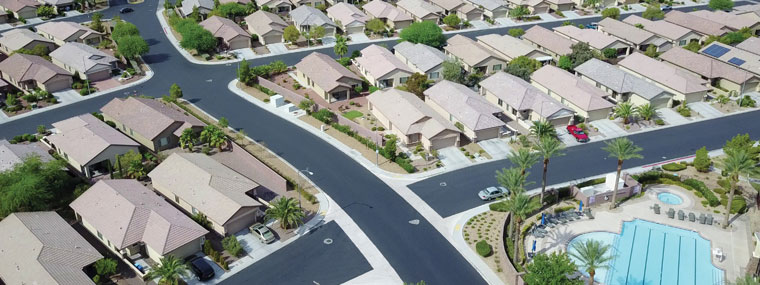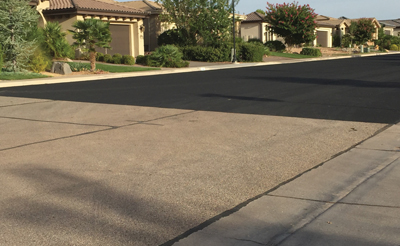
Warning—Problem Identified with Asphalt Preservation Plans
By Mark Beatty / Published April 2021

W
hy Many HOA Boards Unwittingly Choose Less-Effective Methods for Managing Asphalt Street and Parking Assets
Here is a quick story describing why the business model around pavement preservation may have incentives misaligned with your community’s best interests.
Recently, while visiting with the management team for a large pavement maintenance company in another state, I gleaned something that I found disturbing. The more I thought about it, I realized this reputable company was not necessarily doing anything unethical; they were just doing what fits their business model. It is probable that this business model may not be unlike maintenance companies right here in Florida.
As an HOA board, it is essential to understand how the business works, so that you can evaluate treatment types and contractors with greater awareness.
As we discussed their business (which was doing very well I might add), we got to the topic of their customer base. I will give this company the fictitious name Best Seal Coat Company. Best Seal Coat Company prides themselves with working well with customers and striving to do clean work that leaves properties attractive after the project has been completed. The management team was pleased to share how they had significant contracts to maintain the asphalt at large private communities and retail properties. These contracts provided a valuable and consistent income stream for Best Seal Coat Company.
Here is where things began to be a little bit troubling. Their business model is built around low-cost and frequent seal coat application. As we discussed tools in the toolbox available for pavement maintenance, we covered six preservation treatment types. I found some resistance when we began discussing the use of high density mineral bond (HDMB) as well as slurry and microsurfacing. Each of these are longer lasting treatments; however, a longer lasting solution wasn’t necessarily something that Best Seal Coat Company was focused on.
The option of slurry and microsurfacing was something they dismissed because of the negative side effects associated with the treatment, such as its rough texture, months of shedding small aggregate post installation, etc. As a result, I understood the reasoning behind dismissing that option.
 When we discussed high density mineral bond as an option for them to use, they were less than enthusiastic. Why? It’s because the product has aesthetics that residents embrace, with its deep black color, and preservation performance that easily doubles and often triples that of seal coat products. Yet, it became clear that the idea of providing high density mineral bond brought concern to the Best Seal Coat management team as they would lose their regular, more recurrent projects because the average cycle times or frequency of application for HDMB installations are consistently cycling two-three times that of seal coat. Seal coat products, on the other hand, more consistently rank in the two to three-year range. Because their business model relies on regular treatment intervals, they chose to avoid a surface treatment that would be in the best interest of their customers.
When we discussed high density mineral bond as an option for them to use, they were less than enthusiastic. Why? It’s because the product has aesthetics that residents embrace, with its deep black color, and preservation performance that easily doubles and often triples that of seal coat products. Yet, it became clear that the idea of providing high density mineral bond brought concern to the Best Seal Coat management team as they would lose their regular, more recurrent projects because the average cycle times or frequency of application for HDMB installations are consistently cycling two-three times that of seal coat. Seal coat products, on the other hand, more consistently rank in the two to three-year range. Because their business model relies on regular treatment intervals, they chose to avoid a surface treatment that would be in the best interest of their customers.
While considering all the tools in the pavement management toolbox, this well-respected company felt that using a high density mineral bond would significantly reduce their profitability due to a reduction in the number of projects. Unfortunately, Best Seal Coat Company was unable to see past their short-term incentives, which lead to prioritizing profit over providing what was in their clients’ long-term best interest.
How to Do Wonders with a Small Budget
Knowing that your go-to contractors may not have the incentive to recommend the right treatment strategy for your roads, you may now be wondering what the different options for treatment types are.
While considering treatment types, you should focus on maximizing the extension of pavement life at the lowest possible cost over time. There are many treatment types, such as seal coats, fog seals, slurry seals, chip seals, high density mineral bond installations, etc., that are all able to turn your pavement black. They are not all equal, however, in terms of extending pavement life.
High Density Mineral Bond (HDMB): In a side-by-side case study comparing seal coat to HDMB, the HDMB treated section was found to have nine times less cracking after a four-year period. The role of HDMB is to effectively extend the life of pavement assets while lowering the cost of ownership. Performance durability combined with a long-lasting, deep black color that residents embrace is what has driven the rapid adoption of the surface treatment by HOAs.
Fog Seals: A fog seal is an asphalt emulsion spray applied that is most appropriately used as a short-term assistance to pavement maintenance or as a temporary binder on top of a chip seal treatment.
Seal Coats: A seal coat is a thin liquid application which consists of a chemically emulsified asphalt liquid mixed with fillers, water, and various additives. Roads and parking lots with seal coats installed turn an attractive black, but the benefits are relatively short lived as drawbacks include a lack of durability, and a lack of effective industry standards promotes unreliable quality. Frequent applications are required to ensure protection from the environment. The lack of resilience elevates the life-cycle cost over slurry or HDMB applications.
Slurry (Types I, II, and III): Slurry is effective on moderately distressed roadways requiring minor rehabilitation. Type III can be used on heavy load, high volume, high speed roadways. Greater durability is found with slurry compared to seal coats, but the texture, shedding, and loss of black color can leave HOA residents dissatisfied.
Selecting the right preservation tool for the condition of your community’s streets supports the following:
- Lower ownership costs
- Higher property values
- Reduced road closures
- Conservative association fees
Seeing that seal coats are not the only tool in the toolbox (unlike the Best Seal Coat Company described above), will help you bring significant value to your HOA. In fact, understanding how to effectively use pavement treatments is unquestionably the most important element in stretching your maintenance dollars.
Mark Beatty
Senior Vice President, Holbrook Asphalt Company
Mark Beatty is on the Advisory Board for the International Pavement Management Association and consults with public agencies and HOAs throughout the U.S. He is a sought-after presenter at public works events as well as HOA seminars. Mark serves as the Sr. Vice President at Holbrook Asphalt Company. You can contact Mark at mark@holbrookasphalt.com.
For a free Asset Preservation Journal detailing the pros and cons of various maintenance treatments, email report@preserveasphalt.com with Asset Journal in the subject line.
In addition, if you wish to receive a free PCI (pavement condition index) rating, email me. I’ll put you in touch with a qualified pavement management advisor.




